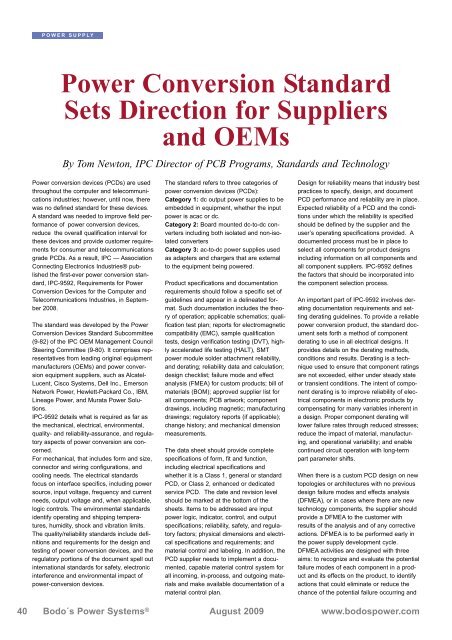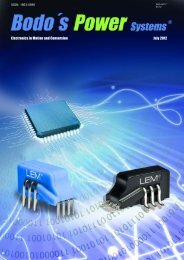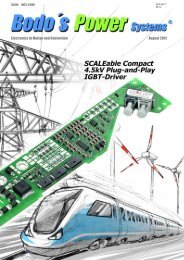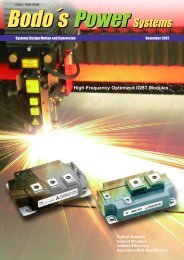Features - Bodo's Power
Features - Bodo's Power
Features - Bodo's Power
Create successful ePaper yourself
Turn your PDF publications into a flip-book with our unique Google optimized e-Paper software.
POWER SUPPLY<br />
<strong>Power</strong> Conversion Standard<br />
Sets Direction for Suppliers<br />
and OEMs<br />
By Tom Newton, IPC Director of PCB Programs, Standards and Technology<br />
<strong>Power</strong> conversion devices (PCDs) are used<br />
throughout the computer and telecommunications<br />
industries; however, until now, there<br />
was no defined standard for these devices.<br />
A standard was needed to improve field performance<br />
of power conversion devices,<br />
reduce the overall qualification interval for<br />
these devices and provide customer requirements<br />
for consumer and telecommunications<br />
grade PCDs. As a result, IPC — Association<br />
Connecting Electronics Industries® published<br />
the first-ever power conversion standard,<br />
IPC-9592, Requirements for <strong>Power</strong><br />
Conversion Devices for the Computer and<br />
Telecommunications Industries, in September<br />
2008.<br />
The standard was developed by the <strong>Power</strong><br />
Conversion Devices Standard Subcommittee<br />
(9-82) of the IPC OEM Management Council<br />
Steering Committee (9-80). It comprises representatives<br />
from leading original equipment<br />
manufacturers (OEMs) and power conversion<br />
equipment suppliers, such as Alcatel-<br />
Lucent, Cisco Systems, Dell Inc., Emerson<br />
Network <strong>Power</strong>, Hewlett-Packard Co., IBM,<br />
Lineage <strong>Power</strong>, and Murata <strong>Power</strong> Solutions.<br />
IPC-9592 details what is required as far as<br />
the mechanical, electrical, environmental,<br />
quality- and reliability-assurance, and regulatory<br />
aspects of power conversion are concerned.<br />
For mechanical, that includes form and size,<br />
connector and wiring configurations, and<br />
cooling needs. The electrical standards<br />
focus on interface specifics, including power<br />
source, input voltage, frequency and current<br />
needs, output voltage and, when applicable,<br />
logic controls. The environmental standards<br />
identify operating and shipping temperatures,<br />
humidity, shock and vibration limits.<br />
The quality/reliability standards include definitions<br />
and requirements for the design and<br />
testing of power conversion devices, and the<br />
regulatory portions of the document spell out<br />
international standards for safety, electronic<br />
interference and environmental impact of<br />
power-conversion devices.<br />
The standard refers to three categories of<br />
power conversion devices (PCDs):<br />
Category 1: dc output power supplies to be<br />
embedded in equipment, whether the input<br />
power is acac or dc.<br />
Category 2: Board mounted dc-to-dc converters<br />
including both isolated and non-isolated<br />
converters<br />
Category 3: ac-to-dc power supplies used<br />
as adapters and chargers that are external<br />
to the equipment being powered.<br />
Product specifications and documentation<br />
requirements should follow a specific set of<br />
guidelines and appear in a delineated format.<br />
Such documentation includes the theory<br />
of operation; applicable schematics; qualification<br />
test plan; reports for electromagnetic<br />
compatibility (EMC), sample qualification<br />
tests, design verification testing (DVT), highly<br />
accelerated life testing (HALT), SMT<br />
power module solder attachment reliability,<br />
and derating; reliability data and calculation;<br />
design checklist; failure mode and effect<br />
analysis (FMEA) for custom products; bill of<br />
materials (BOM); approved supplier list for<br />
all components; PCB artwork; component<br />
drawings, including magnetic; manufacturing<br />
drawings; regulatory reports (if applicable);<br />
change history; and mechanical dimension<br />
measurements.<br />
The data sheet should provide complete<br />
specifications of form, fit and function,<br />
including electrical specifications and<br />
whether it is a Class 1, general or standard<br />
PCD, or Class 2, enhanced or dedicated<br />
service PCD. The date and revision level<br />
should be marked at the bottom of the<br />
sheets. Items to be addressed are input<br />
power logic, indicator, control, and output<br />
specifications; reliability, safety, and regulatory<br />
factors; physical dimensions and electrical<br />
specifications and requirements; and<br />
material control and labeling. In addition, the<br />
PCD supplier needs to implement a documented,<br />
capable material control system for<br />
all incoming, in-process, and outgoing materials<br />
and make available documentation of a<br />
material control plan.<br />
Design for reliability means that industry best<br />
practices to specify, design, and document<br />
PCD performance and reliability are in place.<br />
Expected reliability of a PCD and the conditions<br />
under which the reliability is specified<br />
should be defined by the supplier and the<br />
user’s operating specifications provided. A<br />
documented process must be in place to<br />
select all components for product designs<br />
including information on all components and<br />
all component suppliers. IPC-9592 defines<br />
the factors that should be incorporated into<br />
the component selection process.<br />
An important part of IPC-9592 involves derating<br />
documentation requirements and setting<br />
derating guidelines. To provide a reliable<br />
power conversion product, the standard document<br />
sets forth a method of component<br />
derating to use in all electrical designs. It<br />
provides details on the derating methods,<br />
conditions and results. Derating is a technique<br />
used to ensure that component ratings<br />
are not exceeded, either under steady state<br />
or transient conditions. The intent of component<br />
derating is to improve reliability of electrical<br />
components in electronic products by<br />
compensating for many variables inherent in<br />
a design. Proper component derating will<br />
lower failure rates through reduced stresses;<br />
reduce the impact of material, manufacturing,<br />
and operational variability; and enable<br />
continued circuit operation with long-term<br />
part parameter shifts.<br />
When there is a custom PCD design on new<br />
topologies or architectures with no previous<br />
design failure modes and effects analysis<br />
(DFMEA), or in cases where there are new<br />
technology components, the supplier should<br />
provide a DFMEA to the customer with<br />
results of the analysis and of any corrective<br />
actions. DFMEA is to be performed early in<br />
the power supply development cycle.<br />
DFMEA activities are designed with three<br />
aims: to recognize and evaluate the potential<br />
failure modes of each component in a product<br />
and its effects on the product, to identify<br />
actions that could eliminate or reduce the<br />
chance of the potential failure occurring and<br />
40 Bodo´s <strong>Power</strong> Systems ® August 2009 www.bodospower.com







